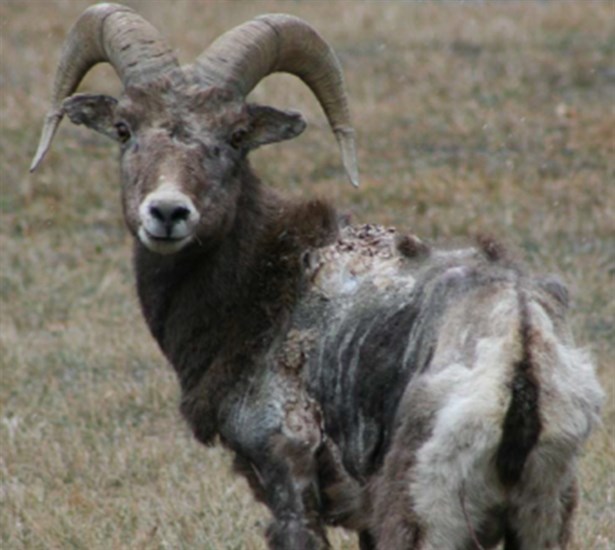
A bighorn sheep in the Olalla herd of the Similkameen Valley with Psoroptic mange.
Image Credit: WIldlife Health Fact Sheet photo
February 07, 2017 - 9:00 PM
PENTICTON - Bighorn sheep in the South Okanagan are facing a new threat on the heels of a pneumonia outbreak in 1999 that decimated the bighorn sheep herd around Vaseux Lake.
Ministry of Forests, Lands and Natural Resource Operations Communications Officer Dave Townsend says ministry technicians discovered Psoroptes obis, or sheep mange, in Similkameen Valley bighorn sheep populations in 2011.
It’s the first time the disease has been seen in Canada since being eradicated from domestic sheep herds in the 1920s.
Townsend says the ministry has been collaring and monitoring bighorn sheep across the infected area, tracking 60 sheep out of the estimated population of three to four hundred in the area so far.
The disease causes hair to fall out, resulting in scaly crusts that may spread to other parts of the body. The animal gets itchy and damages its skin by scratching, resulting in secondary bacterial infections.
Eventually, the sheep lose weight and appetite, resulting in anemia and emaciation.
The reaction to mites in a herd is widely varying, from few signs, such as a few mites in the ears, to massive fatal infections.
The disease can spread to domestic sheep.
The affected herds are in areas west of the east side of the Okanagan Valley. Efforts are being made over the winter to remove bighorn sheep from the McIntyre Bluff area, deemed to be the highest risk area for transmission of the disease to the east side populations.
In some places the valley floor is only 400 metres wide. Ministry officials are concerned infected sheep could potentially come into contact with healthy sheep from the east side of the valley.
By transferring the sheep to areas of the Similkameen where populations have been depressed, the ministry hopes to create a buffer zone around of about 1.6 kilometres between the herds, and also assist in the rebuilding of herds in that area that have been affected by the disease.
To contact a reporter for this story, email Steve Arstad or call 250-488-3065 or email the editor. You can also submit photos, videos or news tips to the newsroom and be entered to win a monthly prize draw.
We welcome your comments and opinions on our stories but play nice. We won't censor or delete comments unless they contain off-topic statements or links, unnecessary vulgarity, false facts, spam or obviously fake profiles. If you have any concerns about what you see in comments, email the editor in the link above.
News from © iNFOnews, 2017